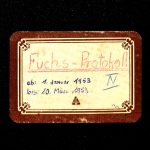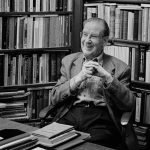Contributor Essays
Temporalizing Space through Sound and Movement
the Günter Tembrock protocols on fox behavior
by Sophia Gräfe and Alexandra Hui
July 29, 2020
In 1948, Günter Tembrock (1918–2011) established the Forschungsstätte für Tierpsychologie (Research Centre for Animal Psychology), which would become an important nexus for behavioral biology in the GDR. As director of the Zoological Institute at Humboldt University of Berlin, Tembrock oversaw the establishment of the Tierstimmen (animal sound) collection. Under Tembrock’s leadership, this collection grew to over 100,000 recordings of animal sounds; the Tierstimmenarchiv (Animal Sound Archive), now part of the Berlin Museum für Naturkunde, is the largest bioacoustic collection in Europe. This article accompanies the digitized versions of Tembrock’s research diaries, the “Fox Protocols,” available in the Sound & Science: Digital Histories database. Created between 1953 and 1967, these handwritten logbooks provide insight into the biologist’s daily research practice.
In the 1950s, a new epistemological framework emerged within the field of behavioral research—one that, for the first time, made extensive use of audiovisual as well as handwritten media to map and navigate the experimental topography. Drawing upon the ethological methods of Oskar Heinroth, Niklaas Tinbergen, Konrad Lorenz, and others, German scientists sought to bolster their observations of animals with (more) precise, verifiable, and diverse research data. What had previously been a discipline centered around the classical ethogram—that is, detailed written reports on behavioral repertoires—was now expanded. In addition to handwritten resources such as protocols, sketches, and keyword indexes, there were photographs, films, sound recordings, and actograms (kymographs). This practice decisively shaped the media geography of the young discipline of behavioral biology. Not only was the means of representing behavioral patterns and potentials widened but the concept of behavior itself was expanded. Thus transposed into a medial space, behavioral biology became subject to the data-driven mapping of all earthly movement by the mid-twentieth century.
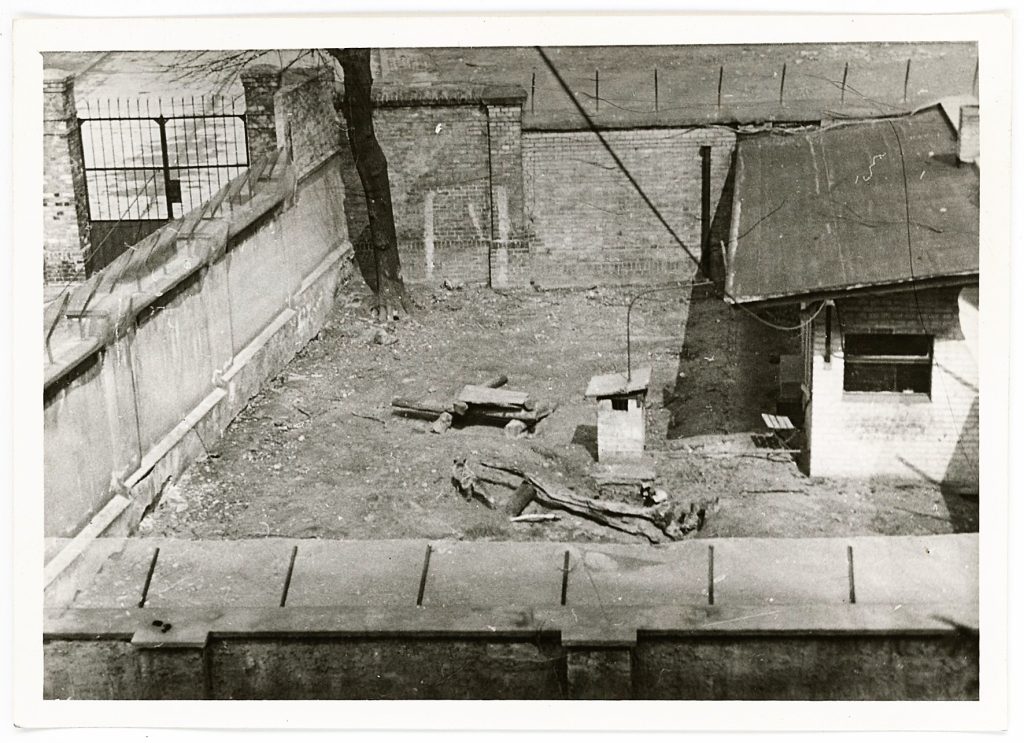
The first image (Fig. 1) shows a photograph taken in the 1950s of the open-air enclosure of the Forschungsstätte für Tierpsychologie (Research Center for Animal Psychology) in Berlin. Beginning in 1948, Günter Tembrock, a pioneer of modern behavioral biology and staff member of Humboldt’s Institute of Zoology, kept his laboratory animals in this space—not only in the Institute’s working rooms but also in the garden of what is today the Museum für Naturkunde. Alongside squirrels, rats, mice, dogs, cats, wood owls, jackdaws, blackcaps, golden hamsters, and cichlids, he and the zoo directors (who were friends of his) welcomed red foxes that had been domesticated by citizens of the new socialist state. (Fig. 2) Some of these animals were found; some had been captured. In subsequent decades, Tembrock put his experimental animals into the service of behavioral science. Doing so required, above all else, an accurate and meticulous recording of all behavioral data.
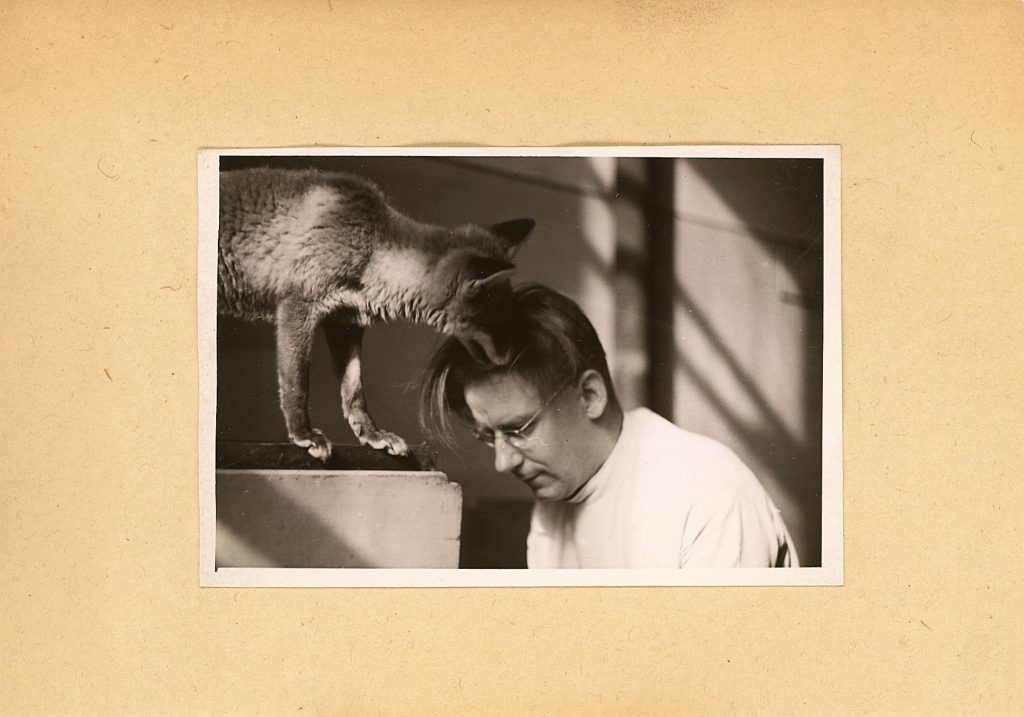
Accuracy is the keyword here. In order to compete with American behavioral laboratories and Russian behavioral physiology (both focused on reflexes), the highest measure of objectivity was crucial. In the photograph (Fig. 1), one can observe that the open-air fox enclosure in the garden is an ecosystem of various recording media. Tembrock recorded fox movements and sounds from both an elevated vantage point (his office) as well as from within the open-air enclosure (inside the observation house). Handwritten protocols and drawings of behavioral expressions, photographs, sound and film recordings, and even activity graphs using a kymograph half-buried in the ground were produced daily—often several times per hour.
The resulting data of this multimedia observational practice can be read as a cartography of behavior. Components of ritualized behavioral programs such as the rut—ritualized fighting and play—were recorded in a seemingly nonintrusive way to capture their respective relations and interdependencies. In order to clarify what we term the “ecology” of behavior, Tembrock produced extensive daily protocols that referred to the activities of the animals in the enclosure with the aid of short notations (Fig. 3) and directional arrows. Temporal and geographical information and metadata attributed individual behaviors to a specific place and time. Occasionally, the researchers conducted experiments with the animals and staged encounters with stuffed animals from the museum’s collection or confronted the animals with sound recordings from the growing Tierstimmenarchiv.
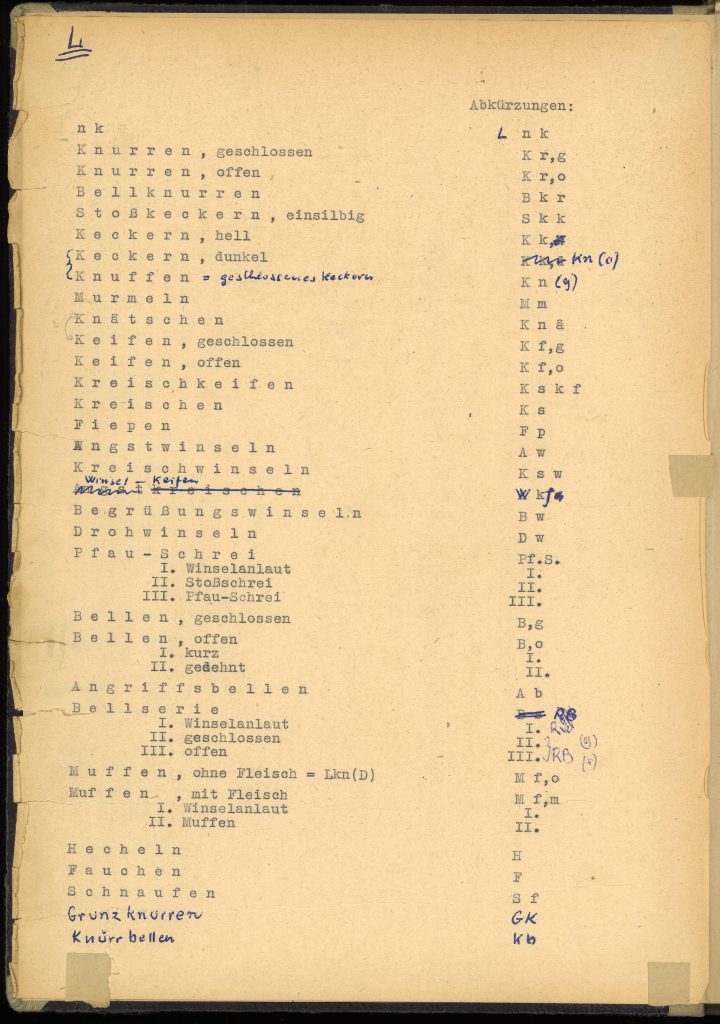
It is thus evident that the biologist’s laboratory diaries and subsequent evaluation protocols distributed behavior over spatial and temporal orders and the causal mediations between them. Inscribed in Tembrock’s research papers was no less than the cosmos of a single motion embedded within its spatiotemporal conditions and biological functions. It seems that the notebooks had a twofold function: First, they collected, accumulated and ordered data in “logbooks” of behavior; second, they defined this epistemic space by rendering behavioral expression into a network of causal relationships.
It is perhaps fitting that the ethnographic studies of science a generation ago give us methodological tools to approach Tembrock’s animal behavior laboratory. In their study of the Salk Institute, Bruno Latour and Steve Woolgar monitored in situ the steady stream of activity in the laboratory space, documenting the construction of scientific objects and facts: the ordering of disorder. This and subsequent scholarship has highlighted the entanglement of textual and visual production and the representation of scientific ideas. This goes beyond semiotics: Epistemic and ontological work is also frequently entangled, especially in the act of documenting observations. The very act of documentation—putting pen to the paper of the lab notebook—creates and maintains frameworks of understanding.
Recently scholars have moved beyond textual and visual media and materialities of scientific practices to other sensory modalities. Take sound, for example. As evident in this digital database, the collection and documentation of sounds in the laboratory offers a rich point of entry into understanding the creation of scientific knowledge more generally. Motivated by his push for a data-driven behavioral science, Tembrock’s meticulous efforts to document the sounds and motions of his research subjects— a leap here, a “yip!’” there—temporalized his laboratory space. Aggregated over weeks and months, such minutiae revealed rhythms and patterns. Over time, specific events became behavior.
In this way, we might think about the Tembrock protocols as an example of field science collecting practices (re)entering the laboratory. In contrast to earlier cases of field recordings that were valuable in their temporal and spatial specificity but were sterilized once they entered the lab or archival space, Tembrock preserved the wildness of his foxes. Indeed, his real-time documentation of fox activity maintained the specificity that traditionally distinguishes field sciences from lab-based ones. In other words, Tembrock’s careful documentation techniques preserved his subjects’ wildness while his protocols made it possible to study wild fox behavior within the confines of a museum-based laboratory in East Berlin.
* To contact the Tembrock Research Collection follow this link: https://www.sammlungen.hu-berlin.de/sammlungen/tembrock-forschungssammlung/.
Visit https://www.tierstimmenarchiv.de to access the Animal Sound Archive at the Museum für Naturkunde in Berlin, founded by Tembrock.
Header image: View of an exemplary daily protocol of the lab animal’s behavior feat. notes on sound recording (1957), © Hwa Ja Götz, MfN


